Type 1: Full Face Helmets
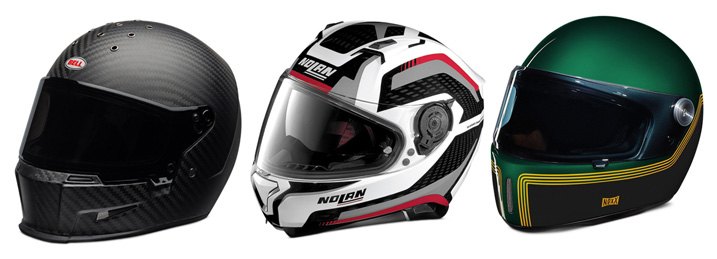
Covering the front, back, and top of the head, full face helmets offer the most complete protection of all helmet styles. Full face helmets, traditionally round and bubble-shaped, usually feature aerodynamics that have been optimized for various riding positions. Regardless of their exact shape and look, full face helmets are stronger structurally thanks to a beefy chin bar that’s integrated into the rest of the helmet. Wind visors in front can be opened or closed easily.
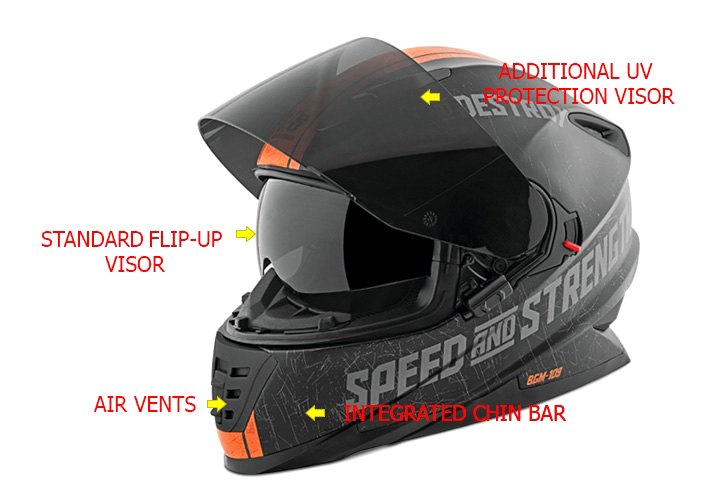
With the visor closed, a full face helmet could become a sealed-off bubble without proper ventilation. To prevent this, enclosed helmets feature ventilation channels in the front, sides, and top which allow fresh air to flow throughout the helmet for easier breathing and reduced fog-up.
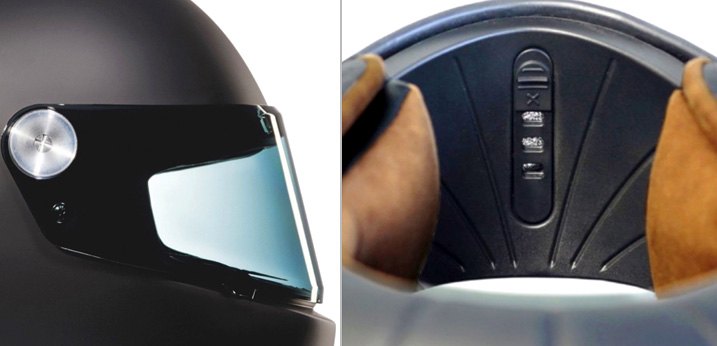
Type 2: Modular Helmets
Modular helmets are equipped with chin bar sections that pivot upward on rear hinges. So when you need to take a quick break to make a phone call, eat, check GPS, or discuss events of the trip, a quick flip of the chin bar transforms what’s essentially a full face helmet into an open face one. Modular helmets range in shape from round (ideal for lower speeds and more upright riding styles) to slightly elongated (more aerodynamic for faster riding).
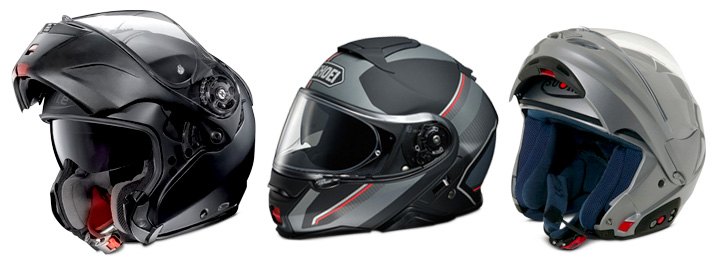
It’s important to note that modular helmets do not have the strength and crash integrity that full face (one-piece) helmets do. While lower chin sections are reinforced for strength, they are separate pieces from the rest of the helmet – causing them to respond differently in a crash.
Because of those strength reinforcements found in chin and other areas of the helmet, and because of numerous components used in the heavy-duty pivot hinges, modular helmets typically weigh more than full-face helmets.
Type 3: Open Face Helmets
As long-time favorites of lower-speed bikers and scooter riders, Open Face Helmets cover the sides, top, and back of the head while leaving facial areas completely exposed to the fresh breeze. Because there’s no structural chin section, open face helmets offer less crash protection. An adjustable strap around the chin keeps them securely fastened to your head.

Naturally, that great open-air feeling comes with a down side - exposure to road grit, bugs, water, and more. However, many open face helmets can be purchased with removable visor pieces and air filtering face masks.
Type 4: Dirt Bike Helmets (a.k.a. "Off-Road" Helmets)

Because off-road riding on dirt bikes requires more physical exertion, dirt bike helmets are lightweight and designed for maximum ventilation so the rider can breathe easily – especially during the warmer months of off-roading. Contributing to the need to stay cool, dirt bike helmets also feature less insulation inside. One-piece construction offers superior levels of protection around the chin area.
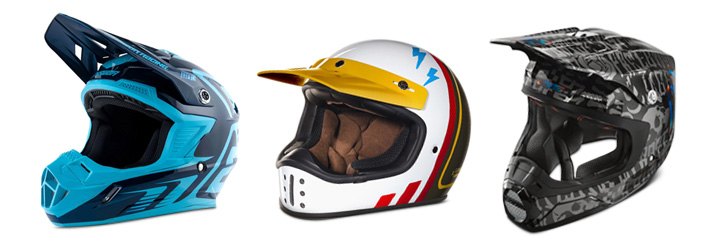
Because dirt bike helmets aren't intended for high speeds and do not include a wind visor, riders typically wear separate goggles inside the helmet for eye protection. This is actually a positive because goggles are much easier to remove and clean when everything gets mud covered.

Off-road helmets feature large, adjustable "sun peak" attachments which serve several functions. First, they keep sun glare out of the eyes – something that’s more of a factor when you’re riding up and down hills at extreme angles while off-roading.

Secondly, if you’re behind another rider or riders on a dirt trail, sun peaks effectively block a lot of dirt and mud kicked up by their rear wheels. This arc of mud spraying into the air behind a dirt bike is known as a “rooster tail” because of its visual shape. Consequentially, being “roosted” by another rider is no fun, and can be quite painful when rocks are thrown.
Due to lighter weight and lower insulation, you'll hear the most noise inside a dirt bike helmet. However, this is beneficial at lower speeds over rough terrain when such sounds are necessary to determine if tires are sliding, skidding, or maintaining contact.
Note that levels of wind and noise inside a dirt bike helmet can get extremely unpleasant during high speed riding. Sun peaks would also catch unsafe levels of aerodynamic force - continuously pushing your head up and back. For these reasons, dirt bike style helmets are designed to be used at lower speeds.
Those who plan to do off-road racing or just extreme stuff may appreciate dirt bike helmets made of lighter weight composites.
Type 5: Dual Sport Helmets
Dual Sport helmets are essentially dirt bike helmets that have been re-engineered for street use at moderate highway speeds. For on-road riding, ventilation is much improved through ducts and vents, and face shields can be flipped down when you're on the move. Or, flip the face shield up for use with goggles during off-roading.

Unlike dirt bike helmets, dual sport helmets have permanently integrated chin bars for better jaw protection. They also feature glare-reducing sun peaks that aren't as subject to aerodynamic lift when speeds increase.
To keep the rider comfortable during on-road use, dual sport helmets feature more insulation for sound muffling and warmth than dirt bike helmets - but not as much as full face helmets.
Type 6: Half Shell Helmets
Simply put, half shell helmets are really for style and enjoying the wind in your face. Technically, they provide the minimum required head coverage of upper front, top, side, and rear areas.
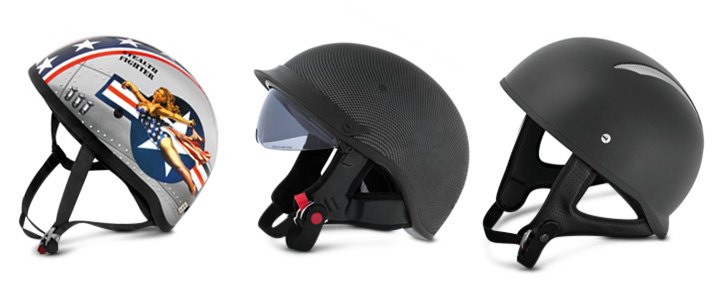
Because half shells let you see the sights, hear the sounds, and smell the aromas better than any other type of helmet, they're valued by riders of vintage classics and cruiser bikes. To shield the face and mouth from bugs and other road grit, sunglasses, goggles, and bandannas are often worn (see our Motorcycle Head Gear section).

Our website makes it as easy as possible for you to narrow down your search for the ideal helmet. Across the top and on the left side of the screen are identical menus listing all the helmet types. You can click on one or more of the types which interest you. The products that appear will be ones in that category, which saves you from scrolling past the ones you aren't considering.
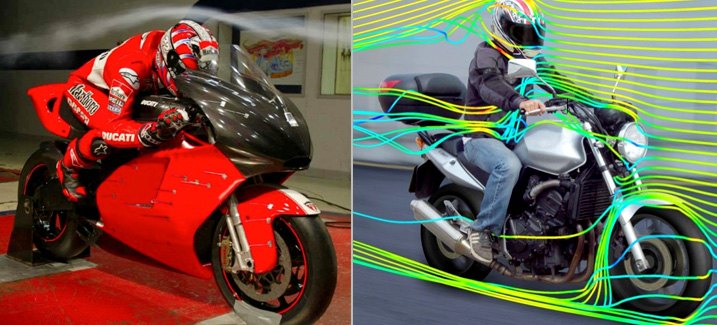
When selecting a helmet, think about your riding position. For example, will you be crouched down on a speed bike? Or sitting upright on a cruising bike? With each riding position, a helmet with the right visibility and ergonomics will make your life easier. While this naturally applies to all helmets, how you sit on the seat must absolutely be considered when it comes to more restrictive full face helmets.
Riding surfaces, average speeds, helmet weight, desired visibility, ambient temperature, and overall comfort are all important factors to also consider when making a helmet choice.
To summarize, each of the six major helmet types has its advantages. The decision is yours based on your unique ridership needs. If you have a need to consult with a riding professional, feel free to call us toll-free seven days a week. We're here to help, and we look forward to hearing from you!
